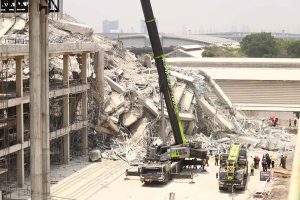Thai rescuers used a crane on the morning of April 2 to remove the body of a female worker from the rubble of a 30-story building in Bangkok’s Chatuchak district that collapsed in an earthquake last weekend.
Authorities confirmed that 15 people were killed in the collapse of the State Audit Office (SAO) building under construction, including 7 women and 8 men. Nine others were injured in the incident, with 72 workers trapped in the huge rubble. Most of the workers trapped in the building are believed to be immigrants from surrounding countries, such as Myanmar and Cambodia.

Thai media yesterday quoted information from the Ruamkatanyu Foundation, a long-standing charity in Thailand, saying that US military sensors had detected humanoid dots in the middle of the collapsed State Audit Office building.
These points were found on floors 17 to 21, where most of the missing people were working when the 7.7-magnitude earthquake struck. Bangkok Deputy Governor Tavida Kamolvej said it was still unclear whether all 70 points were missing people. However, 6 of them have been identified as human bodies.
Rescuers said they were mobilizing all human and material resources to search for those trapped in the collapsed building, but admitted that it was difficult to speed up the work. Because 30 floors under construction collapsed on top of each other, they could not determine which floor the trapped people were on.
As the search enters its fifth day, officials are constantly adjusting their plans to save as many people as possible, said Tavida Kamolvej, deputy governor of Bangkok.

In the coming days, rescuers will insert search cameras into gaps to scan for signs of life and bodies, and pinpoint where survivors may be trapped.
Bangkok Governor Chadchart Sittipunt said it was not yet safe to remove the concrete blocks, as they could destabilize the structure, endangering the lives of survivors and rescue workers.
Thai Prime Minister Paetongtarn Shinawatra announced on April 1 that the building collapse was not only an earthquake accident, but also affected the image of Thailand. She ordered relevant agencies to investigate China Railway No 10 Engineering Group (Thailand), the contractor that built the project, to review whether the projects they have undertaken are safe and meet standards.
“All buildings in Bangkok must meet standards. Safety must be the top priority,” the Thai prime minister said, adding that authorities would also investigate allegations that substandard steel was used to build the SAO building.
Earlier in the day, the Thai Iron and Steel Institute said that some steel samples collected at the scene did not meet standards for weight, composition and load-bearing capacity before fracture.
The Thai Ministry of Industry said the steel came from a factory that authorities had ordered to close late last year for violations, but did not name the company. Images of the steel bars released showed they were branded “Sky”.

The steel bars were produced by Xin Ke Yuan Steel, based in the central Thai province of Rayong. The factory was shut down by authorities in December 2024 following an accident involving a gas leak. Authorities also seized more than 2,400 tonnes of steel from the factory.
The State Audit Office building was the only high-rise building in Bangkok to collapse in the March 28 earthquake, raising questions about the quality of construction, design and materials.


